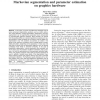Free Online Productivity Tools
i2Speak
i2Symbol
i2OCR
iTex2Img
iWeb2Print
iWeb2Shot
i2Type
iPdf2Split
iPdf2Merge
i2Bopomofo
i2Arabic
i2Style
i2Image
i2PDF
iLatex2Rtf
Sci2ools
JEI
2006
2006
Markovian segmentation and parameter estimation on graphics hardware
In this paper, we show how Markovian strategies used to solve well-known segmentation problems such as motion estimation, motion detection, motion segmentation, stereovision, and color segmentation can be significantly accelerated when implemented on programmable graphics hardware. More precisely, we expose how the parallel abilities of a standard graphics processing unit usually devoted to image synthesis can be used to infer the labels of a segmentation map. The problems we address are stated in the sense of the maximum a posteriori with an energy-based or probabilistic formulation, depending on the application. In every case, the label field is inferred with an optimization algorithm such as iterated conditional mode (ICM) or simulated annealing. In the case of probabilistic segmentation, mixture parameters are estimated with the K-means and the iterative conditional estimation (ICE) procedure. For both the optimization and the parameter estimation algorithms, the graphics processor...
| Added | 13 Dec 2010 |
| Updated | 13 Dec 2010 |
| Type | Journal |
| Year | 2006 |
| Where | JEI |
| Authors | Pierre-Marc Jodoin, Max Mignotte |
Comments (0)

